Microsoft Surface Pro 3 Review
by Anand Lal Shimpi on June 23, 2014 3:55 AM ESTBattery Life
Microsoft made no sacrifice in battery capacity in pursuit of Surface Pro 3's thin chassis design. The new tablet features an integrated 42Wh battery just like the previous two models. Charging duties are handled by an external 31W charger with a brand new magnetic connector. Microsoft never seemed to get a good MagSafe clone working in the previous models, so Surface Pro 3 abandons the previous design entirely in favor of something a bit more sensible.
The new connector no longer looks like an oversized MagSafe connector, and instead features a thin plastic insert that mates with the charge port on Surface Pro 3. Charge time hasn't changed, you can fully charge the device in around 2.62 hours:
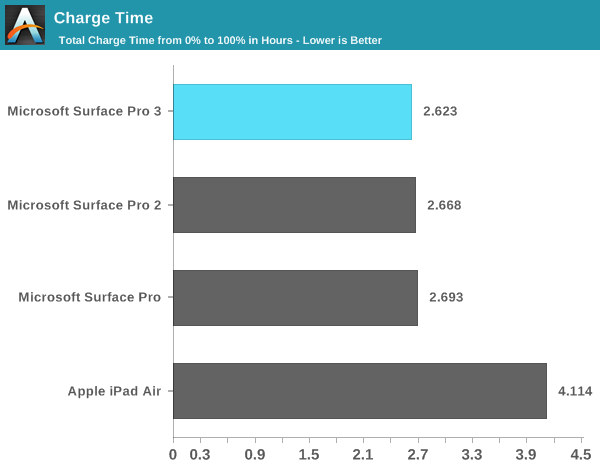
The device-side connector features 40 pins but you only need 12 of them to charge the device. The remaining pins are used for Gigabit Ethernet, USB, DisplayPort (up to 4096 x 2304) and audio. Microsoft seems hell bent on avoiding Thunderbolt at all costs so instead of embracing the standard it has created a custom alternative of its own doing. The benefit to Microsoft's connector is it can obviously deliver more power than Thunderbolt can, the downside is that it can't send PCIe and thus you don't get support for any ultra high bandwidth external storage devices. I still would rather see Microsoft implement Thunderbolt as there's at least an existing ecosystem built around that but here we are three generations into Surface and if we haven't seen it by now I don't think we're ever going to.
The supplied power adapter includes a USB charge port capable of delivering 1A at 5V.
As Surface Pro 3 is designed to be both a laptop and a tablet I've run it through both our Windows laptop battery life tests and our tablet battery life tests.
Laptop Battery Life
As a laptop, Surface Pro 3 delivers comparable battery life to other optimized Haswell ULT designs. I threw in Sony's Vaio Pro 13 into the mix because it has a similar sized battery (37Wh vs. 42Wh) and is one of the most power efficient Windows Ultrabook platforms on the market. Surface Pro 3 manages to deliver similar battery life, which means it's a little less power efficient but the two are within the same range at least.
Compared to Surface Pro 1 and 2, Surface Pro 3 at worst delivers similar battery life and at best increases range on a single charge by up to 20%. We're looking at 3.75 hours - 7.6 hours of notebook usage on a single charge depending on usage.
It's worth noting that there's a substantial advantage in battery life if we look at the 13-inch MacBook Air running OS X. I only mention this because of Microsoft's insistence on comparing Surface Pro 3 to Apple's popular line of notebooks.
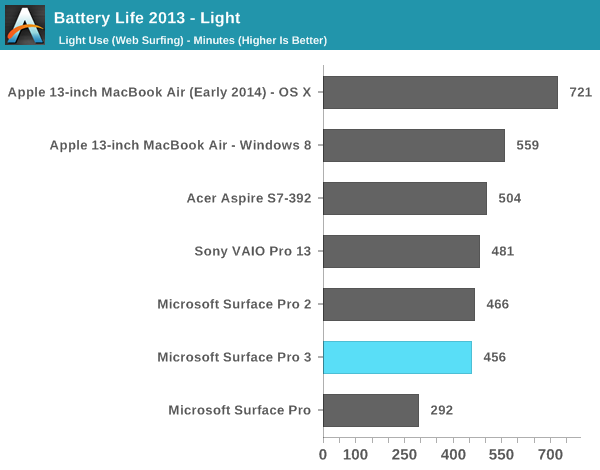

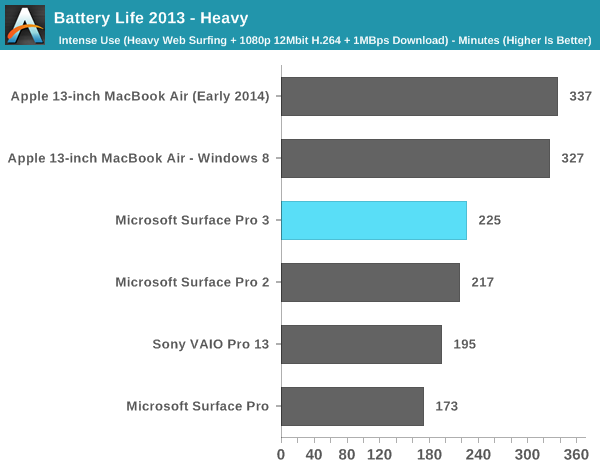
Tablet Battery Life
Tablet workloads are going to be far more display power bound than anything else. Here we see 7.58 - 8.03 hours of continuous usage, a slight regression compared to Surface Pro 2. Video playback remains more power hungry than web browsing, which is something I've noted in previous tablet-evaluations of Intel's Core silicon. I don't believe Intel's Core processors are very optimized for video decode power consumption. If anything is going to change with the move to Broadwell and Core M I suspect video decode power may be it.
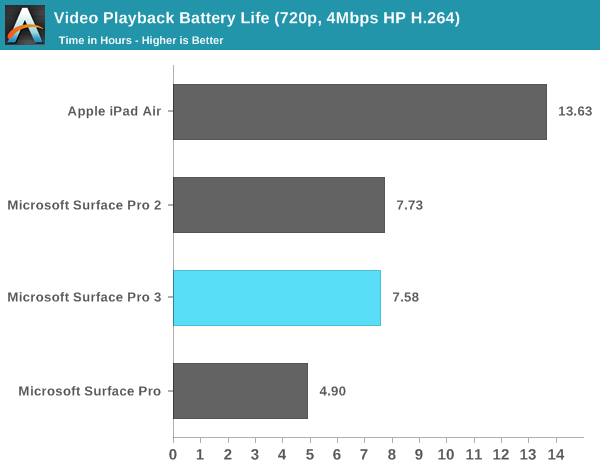
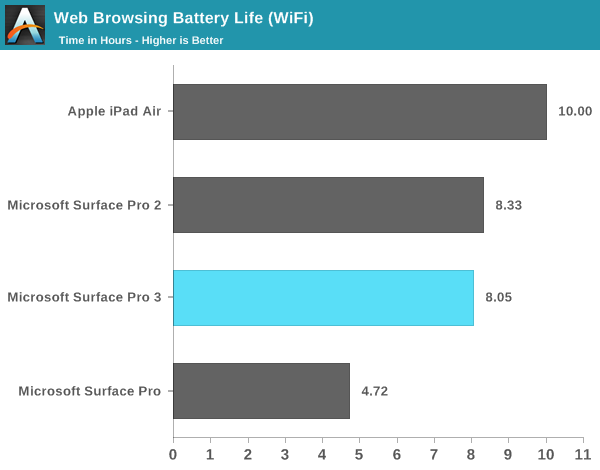


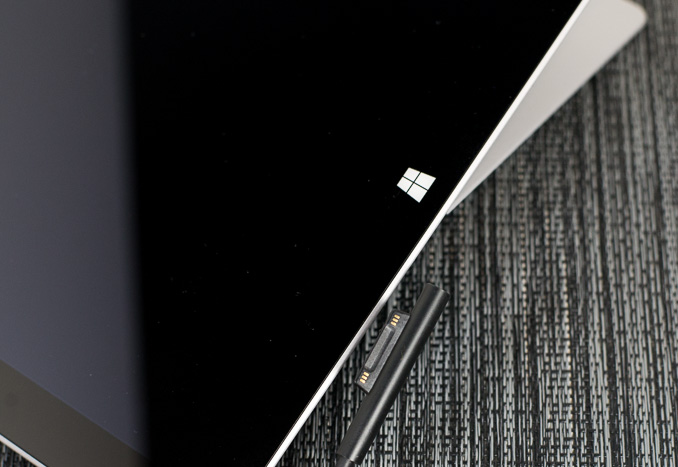
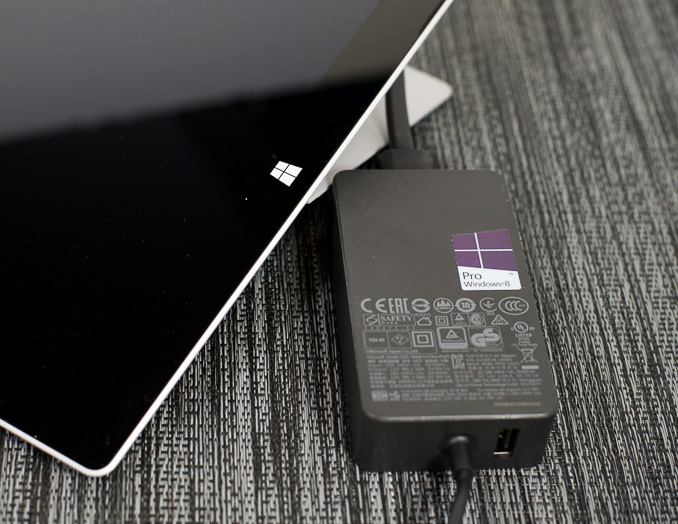








274 Comments
View All Comments
mkozakewich - Monday, June 30, 2014 - link
In that case, you should probably just connect it to a 4K monitor.jjstreic - Tuesday, June 24, 2014 - link
PCIe = Direct Memory Access = Disk encryption security hole (look for firewire exploits). The lack of PCIe is a _good_ thing for security. Also, my reading indicates PCIe is an optional component of Thunderbolt, not mandatory.iceman-sven - Tuesday, June 24, 2014 - link
???One has nothing to do with the other. From http://www.nvmexpress.org:
The NVM Express specification, developed cooperatively by more than 80 companies from across the industry, was released on March 1, 2011, by the NVMHCI Work Group (commonly referred to as the NVM Express Work Group). The NVM Express 1.0 specification defines an optimized register interface, command set and feature set for PCI Express® (PCIe®) Solid-State Drives (SSDs). The NVM Express 1.1 specification was released on October 11, 2012 adding additional Enterprise and Client capabilities. The goal is to deliver the full performance capabilities of current and next generation non-volatile memory, supporting at least a 10 year life of the interface, while standardizing the PCIe SSD interface to enable broad ecosystem support.
The significant advances in performance enabled by non-volatile memory-based storage technology, as embodied in PCIe-based SSDs, has demanded the surrounding platform infrastructure evolve to keep pace, to realize the full potential of these devices. A primary goal of NVM Express is to provide a scalable interface that unlocks the potential of PCIe-based SSDs now and at least a decade into the future. The interface efficiently supports multi-core architectures, ensuring thread(s) may run on each core with their own SSD queue and interrupt without any locks required. For Enterprise class solutions, there is support for end-to-end data protection, security and encryption capabilities, as well as robust error reporting and management capabilities.
There is nothing hindering encryption on a PCIe SSD. And Thunderpolt without PCIe is pure DisplayPort. It makes no sense. And I am sure, DMA is optional and can be blocked per device.
humsinger - Monday, June 23, 2014 - link
This just might be the best review I have ever read. I am usually just a google-what-i-am-looking-for-and-read-the-first-couple-results kind of guy. But after reading this masterpiece I will be on the lookout for anandtech in the future! Thanks for the hard work and keep it coming.nos024 - Monday, June 23, 2014 - link
Not including the keyboard is a deal breaker for me. I'd probably get a Yoga 2 pro over this.nerd1 - Monday, June 23, 2014 - link
Yoga 2 pro is almost the same price, 2X heavier and has 16:9 screen...Carmien - Monday, June 23, 2014 - link
My first impressions - of actually using a Surface Pro 3 - after a few days are really, REALLY good. I'm using the i5 Surface Pro 3 (8 GB RAM) and I've got to tell you it is an amazing piece of hardware. My other laptop is a fully loaded Vaio Z3 that cost twice as much two years ago.As for software, I'm running applications like Office, Novamind, Minitab 16. The design is great. I have no significant issues with heat. I've been enjoying extended Netflix sessions. First, the tablet has gotten "warm" but there are no heat issues. I even went so far as to place it on my bare legs after several hours and there was no discomfort. As an aside, this is the first mobile device where I didn't feel the need to use external speakers. And whatever they're doing with the Dolby codex is working. For two speakers I was very nicely surprised by the sound field for such a small device. It's far from a high end sound system, but it is heads above anything compatible.
As for processing power this is more than capable. I have also been running a workflow designer (browser based), as well as Office apps, and this takes anything I've thrown at it. Reports of wake up issues on sleep or rebooting don't seem to be present for me. MSFT did promise a fix that appears to have made it into release systems. The wake up speed on sleep is instant. Boot up and shut down speeds are much faster than my already capable Z3 (256GB SSD and 8GB RAM with an older i7 CPU).
The keyboard is more than capable. I switch between a Vaio Z3 and the Surface Pro 3 effortlessly. The trackpad isn't as good as the Vaio but the thing is, once you start getting used to the stylus and touchscreen the trackpad really is moot. The only reason I would use the trackpad is because I've forgotten to use the screen or stylus. In other words, the weaknesses on this system get gobbled up by its strengths and then some. If you're capable of changing habits you'll do just fine. After all, touchscreen really is more efficient than a mouse or trackpad - so the return for that change is more than worthwhile.
My favourite feature - the stylus. Taking notes in OneNote is really well done. I can draw process maps and take meeting notes so effortlessly. MSFT finally created an integrated writing solution - and yes, they added a Pen Addin for Office apps as well. Anyone who facilitates meetings and scribes notes for later reference will love this. The weight is amazing - even with the type cover I can carry this around with me comfortably. As a side note, the screensize ratio really is worth it - which reminds me of how good my Netflix viewing experience was last night.
I've used an iPad in the past for a while before setting it down for its lack of functionality, and obviously, the Surface Pro 3 shows it a thing or twenty. Next to a powerful laptop it more than holds its own. The iPad was fun as a tablet, but the Surface Pro 3 is both fun AND functional - It is FUNctional. I do agree with comments about how close MSFT has gotten to getting the hybrid approach right.
I'll see how this handles over time. I've deliberately made a switch in parallel with my other laptop. I can't afford to go without a working computer from a business perspective. But I'm starting to think I could take this as a replacement system on the road. As more applications (that I use) come online designed for Metro the more relevant this tablet/laptop will become.
All in all, this is the most fun I have ever had with a new mobile device. I can see why those locked into the Apple ecosystem will hesitate. But if you are on the fence, or a Windows user, you will really enjoy this. And yes, the cool factor is immense. Who would have imagined that MSFT would design a device that looks just as cool as an iThingy...
Razzy76 - Tuesday, June 24, 2014 - link
I thought the trackpad is very good on SP3, make sure your setting is right. I had to tick Enhance pointer precision and the pointer speed in middle to make the trackpad very responsive.Wolfpup - Monday, June 23, 2014 - link
It might be nice if the i3 model was fanless. The 12" screen (+ real windows) Seems awesome for reading graphic novels and magazines, BUT I'm not sure how I'd feel about a fan going off while I'm reading...Very, very interesting tablet though that I'm toying with getting...
kyuu - Monday, June 23, 2014 - link
The fan will be either off or inaudible during light workloads like reading, especially with the i3 that is a lower TDP than the i5 model in this review. I wouldn't let the worry of fan noise get in the way.